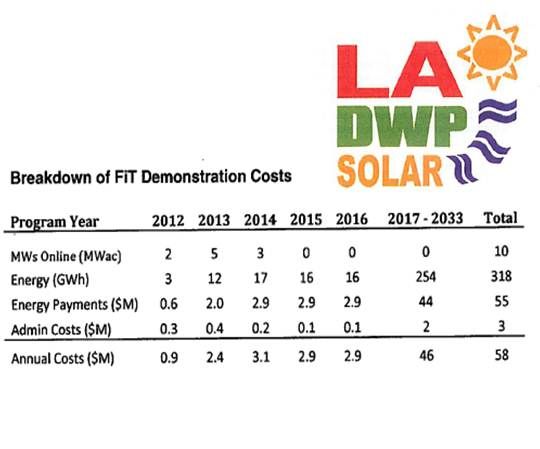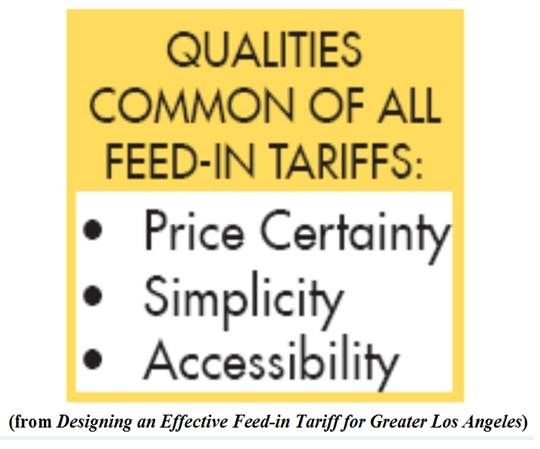After years of contention, the Los Angeles City Council has granted the city’s utility, the biggest municipal utility in the U.S., the power to enter into contracts with solar power producers at above retail rates.
The council delegated to the Los Angeles Department of Water and Power (LA DWP) the right to enter into up to 150 megawatts of feed-in tariff (FIT) contracts with commercial and residential solar power producers.
Like a similar program proposed by LA Mayor Antonio Villaraigosa in 2008, the contracts pre-approved by the City Council allow the DWP to purchase, at an above retail rate (tariff), the electricity fed into the utility’s grid by solar system owners over a pre-designated number of years.
A demonstration FIT plan previously approved by the City Council and already budgeted by DWP allots $58 million over twenty-two years to support ten megawatts of rooftop solar contracts. It is expected to cost $0.9 million in its first year, increase slowly to $2.9 million in 2016 and, finally, to expend $46 million from 2017 to 2033. Its 22-year term is likely indicative of what DWP is considering for larger volume programs
The ten-megawatt demo plan will include systems between 30 kilowatts and 999 kilowatts. The first 8 megawatts, designated for the LA basin, will be for systems between 151 kilowatts and 999 kilowatts. The second 1.7 megawatts, also designated for the LA basin, will be for systems between 30 kilowatts and 150 kilowatts. The last 0.3 megawatts are designated for LA DWP’s Owens Valley service territory and are designated for systems between 30 kilowatts and 150 kilowatts.
The new measure approved by the City Council allows the utility to enter into contracts of up to 150 megawatts.
The approved plan will require approval from the LA DWP’s Board of Directors. Assent is expected.

Feed-in tariffs were conceived in California in the late 1970s as a way to grow renewables by promising a profit over an extended period of time to those willing to risk investing in solar, wind, geothermal and other renewables. The FIT concept was refined in Germany and then in other EU countries from 1999 on.
Advocates say well-designed FITs, with modest tariffs that decline over time in a controlled way as solar capacity grows, drive renewables growth. Opponents claim they inevitably lead to investment bubbles. California’s auction mechanism is an alternative, market-based incentive program. It allows renewable power producers to establish the rate of return in an open bidding process. The DWP demo plan calls for prices set by bidding, using an avoided-cost baseline. Once again, this is likely indicative of what the larger volume contracts will call for.
Villaraigosa kicked off mainstream debate about an FIT program in LA with his 2008 proposal to fund 150 megawatts of solar. Polls showed strong public approval for it and studies by the Los Angeles Business Council (LABC) showed it would create jobs and generate economic activity.
But the Villaraigosa plan ran afoul of ratepayer suspicions about elevated power prices, resistance from LA DWP traditionalists and a controversy between the electricians’ union and independent solar installers over who would have access to the work.

New developments of greater force have moved some of those obstacles aside.
VoteSolar’s Adam Browning, who, along with many other renewables, environmental and grassroots activists, has long fought for an LA FIT, said new California legislation and the efforts of LA DWP General Manager Ron Nichols were the primary drivers behind the City Council’s move.
“There is a huge opportunity,” Browning said of the potential to build rooftop solar in Los Angeles. “LA DWP is the country’s biggest municipally-owned utility,” he noted, but “also the farthest behind in California.” Nichols, Browning said, “is the right person [for the General Manager job] and now we have the force of law.”
Due to initiatives put in place by California Governor Jerry Brown, LA DWP must meet the state’s mandated 33 percent renewables by 2020 standard as well as the SB 32-mandated 75 megawatts of FIT-supported renewables.
Nichols, who took charge at the utility after the Villaraigosa plan was waylaid, told a Los Angeles newspaper that the demonstration FIT program is just the beginning of a larger push by LA DWP for commercial and residential rooftop solar.
"We need to do this,” Nichols was quoted, referring to the demonstration plan, “to learn about the costs and the pricing.” But ultimately, he said, “we hope to have hundreds of these as we go forward."
LABC was credited by Browning and others as one of the key forces in the city council finally turning to the FIT incentive. LABC took up the cause in 2009, backing Villaraigosa by funding five studies that showed how jobs, revenues and pollution reduction benefits would come from driving solar growth.
Approximately eighteen months ago, LABC aligned itself with solar incentive programs emerging across the country and joined the effort to rebrand the FIT concept as a CLEAN Solar program. By enacting its CLEAN Solar FIT program, the LA City Council joined recent new entry Palo Alto, CA. and longstanding members Sacramento,CA, and Gainesville, FL, in the movement.
As recently detailed by GTM, the Palo Alto tariff will be set at its avoided cost price of $0.14 per kilowatt-hour. The Gainesville tariff was in the $0.26 to $0.32 range.



